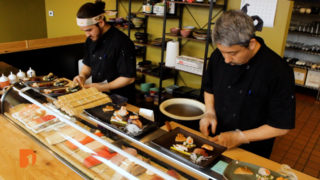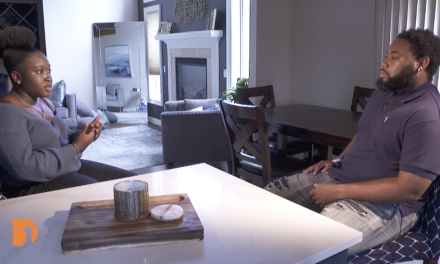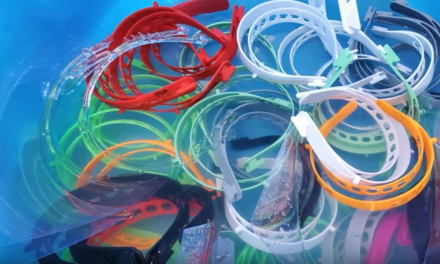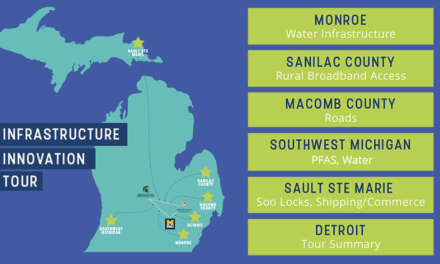To land a spot on the Detroit Free Press’s “Top 10 Best New Restaurants in metro Detroit” list, written by the newspaper’s new Dining & Restaurant Critic Lyndsay Green, restaurants need more than delicious food and an inviting ambiance. In Green’s opinion, restaurants with a large focus on diversity, sustainability and other humanitarian or environmental efforts rose above the rest. Taking the top restaurant spot this year is the Clawson newcomer, Sozai Restaurant.
RELATED: Detroit Free Press | Here are the Top 10 best new restaurants in metro Detroit for 2022

Sozai Restaurant Owner and chef Hamije Sato identifies the fish used in his sustainable sushi dinner plate | Photo by One Detroit
One Detroit Editor Chris Jordan met up with Green at White Wolf Japanese Patisserie, in Clawson’s thriving culinary community, to talk about the sustainability efforts that landed Sozai the top honors this year. Then, Jordan heads down to Sozai Restaurant himself to talk with owner and chef Hajime Sato and get a taste of his sustainable sushi.
Though sustainable sushi isn’t a term you’ll hear mentioned a lot among those in the seafood industry. Chef Sato’s Sozai is only one of a few restaurants across the nation serving sushi sustainably. According to chef Sato, more than one-third of seafood served in America’s restaurants is unsustainable.

Sozai Restaurant owner and chef Hamije Sato (right) preps sushi for dinner at his restaurant with his employee. | Photo by One Detroit
That’s something chef Sato is trying to change, though the trend isn’t quick to catch on. Jordan joins chef Sato at Sozai Restaurant’s sushi bar to learn more about the sacrifice that’s needed to change the landscape of sustainability in seafood, the local fish he features from the Great Lakes, and how sushi lovers can practice greater sustainability while enjoying a meal out. Plus, chef Sato shares his thoughts on what’s cooking in metro Detroit’s culinary scene.
Full Transcript:
Lyndsay C. Green, Restaurant & Dining Critic, Detroit Free Press I wanted to really celebrate restaurants that are bringing a perspective to an area, and I think that that’s what we’re seeing with new restaurants and seeing here in Clawson. For Sozai specifically, it’s that perspective of wanting to serve sustainable sushi.
Chris Jordan, Editor, One Detroit: Clawson, a small metro Detroit city with a thriving restaurant scene. During the first year of the pandemic, we followed Clawson small businesses as they weathered the storm.
Chris Jordan Editor, One Detroit But since then, a new restaurant has opened and was named the Detroit Free Press Restaurant of the Year. Sozai by chef Hajime Sato, a new resident of Clawson who recently moved here from Seattle. Sozai is one of just a small handful of restaurants in the whole country serving sustainable sushi.
I met up with free press food critic Lyndsay Green in downtown Clawson, at White Wolf Japanese Patisserie, to discuss her top ten new restaurants list and why Sozai got the top honor.
Chris Jordan: Your list struck me as very unique because there really was a strong focus on, you know, as you said, all the restaurants on this list, in some way, are building businesses with humanitarian or environmental efforts. Great food is the baseline expectation, but to make that list, you know, restaurants had to be more than just great food.
Lyndsay C. Green: Restaurateurs really were intentional when they launched their restaurants over the past year because I think that they saw what was needed in the industry. I think they saw that you needed to be really mindful of diversity. You needed to be really mindful of things like sustainability. They really needed to pay attention to the impact that a restaurant has on our society and on our community and on the world at large.
The starting point was the traditional great food, great service, great ambiance. And so that’s when I was able to really see, ‘Hey, what are they doing beyond the great food?’. I think what is interesting about Sozai is that sustainability as a pillar at the restaurant goes beyond even just sustainable sourcing. There’s also this concept of sustainability within his hiring practices. I mean, within the staffing, he offers benefits to his full-time employees.
I mean, he offers health insurance, which is something that, you know, you can’t be sustainable if you’re not creating a sustainable environment for your workers. His philosophy of taking that extra step going above and beyond is evident in everything that he does as a side.
Chris Jordan: As a sushi lover, I needed to get the Sozai experience myself. I booked a reservation at their sushi bar and showed up early to speak to Chef Sato and see him and his staff prep the kitchen for dinner service.
Hajime Sato, Chef/Owner, Sozai Restaurant: It is really hard to think that the sushi can be sustainable. Do you eat sushi?
Chris Jordan: Yes, I do.
Chef Hajime Sato: Okay, so what’s your favorite?
Chris Jordan: Now I feel bad to say because I had no idea that eel is a really unsustainable fish. I love like the Unagi Rolls and stuff, but now I know that’s one of the most unsustainable.
Chef Hajime Sato: How about the yellowtail? Do you like that?
Chris Jordan Editor, One Detroit Yep.
Chef Hajime Sato: Okay. That’s not sustainable. How about bluefin tuna? Maybe. Do you know what kind of shrimp that you eat? Where is the shrimp come from? So we are literally talking about four or five species that everybody has. That’s probably 90% of the sales. I cannot use any of that. The sushi chef has to make a decision of changing that. That’s almost impossible. That’s crazy, right?
So that’s why maybe ten of the sustainable sushi place in nation at the time that I switched 13 years ago, and now it’s about ten.
Chris Jordan: Wow.
Chef Hajime Sato: So it’s not really catching on.
Chris Jordan: According to Lyndsay’s article, the amount of sustainable seafood in American restaurants has actually decreased in recent decades, and about 34% of seafood served in America is unsustainable.
Chef Hajime Sato: The thing that really frustrates me, that sushi chef who say like, “Whoa, I have a kids and maybe my kid’s going to, you know, take over my restaurant in future.” Do you understand that? Within like ten, 20 years, you’re not going to get any seafood left when you’re doing what you’re doing.
Sometimes I feel like you can make a little sacrifice in your life. A little bit, right? Then that’s going to change a little bit, right? Crazy guy like me changing the seafood sustainability and this like 25 seating restaurants not going to change anything.
But think about half of the entire population. That’s 10% reduction on, let’s say, “I know cannot eat eel all the time, but maybe I’m not going to eat at maybe ten, 20% of the time.” Entire population did it or half of population did it, that’s going to basically change entire dynamic of anything that you see.
Chris Jordan: Chef Sato’s advice to sushi lovers who want to eat more sustainably?
Chef Hajime Sato: Start with, go to a sushi bar, or any kind of seafood restaurant fishmonger, wherever you go. Just say, “where’s this fish come from?” Right. Why do you have this fish? Just a little something. Is it local? Is it seasonal, whatever that is, right?
That’s going to change a little bit of people’s minds or saying like, “Hey, is this sustainable or not?” Just say that to the people who is serving you. Then maybe they can think twice about, oh, maybe that’s how we have to shift, right? It’s about money. Okay. So ask some questions.
Chris Jordan: How much do you use more local fish or Great Lakes fish?
Chef Hajime Sato: So we use a walleye for we call it a pure Michigan roll, which, you know, people say we you know, they have a California. No, we don’t. We’re not in California. And I use a smelt, also, from Great Lakes. At this moment, those are the two that I use. And of course, I’d like to increase that.
Chris Jordan: But you also you do more vegetarian stuff and more vegetables than a lot of sushi places do.
Chef Hajime Sato: One of the things that’s, I guess if you go to the sushi bar, if you say you’re vegan or vegetarian, then you get like, just, avocado and cucumber roll. We don’t do that. We do a lot of pickled vegetables in the house and we even have it on my cassette, which is the chef’s choice meal for the vegan people. So you’re going to have a lot of choices, which I’m really excited about.
And other side of the coin on this, that the even if you get the sashimi assortment, you’ll get a lot of pickled vegetables. And some people don’t eat it. It’s like, “Eh, it’s vegetable…” And I sometimes make them eat it. Eat your freaking vegetables.
Chris Jordan: And now you mentioned the omakase, the chef’s choice experience at the sushi bar. Tell me a bit about that.
Chef Hajime Sato: I want people to experience something that you would never, ever eat from the menu if it’s there. Most of the people would stick to what they know. And I hate to say this way, but maybe a lot of people like it, but there are some fried roll with the spicy mayonnaise on the top. There is nothing Japanese about that, right?
Chris Jordan: Yeah.
Chef Hajime Sato: That is something that I’d like to change their mind and say, “Hey, there’s a lot more than that.” And yes, you’re used to eat California or the fried California with spicy mayonnaise. And today I might give you the sea snails. But, be open-minded. You might like it. You never know what you’re going to get.
And it’s really fun because even every time you come in and a month’s apart, it’s going to be different, right? And sometimes I talk to the customers and even exactly the same omakase from the menu, I might do a touch different because I talk to the customers. Maybe they like this way. Maybe I can push a little better this way. So every time it’s different. That’s why there’s a counter space over here. That’s the only time I do omakase and not at the table. Because I like to talk to the customers and get a feel.
I think relationships are so important, especially these days. Everything’s kind of Internet based and there’s no human contact that much. You know, people I think, misses that part of it in a restaurant, too. It’s so mechanical sometimes, right?
Chris Jordan: Right.
Chef Hajime Sato: I’m more old school. I like to have a regular customer for life.
Chris Jordan: And as a relative newcomer to Detroit from the Seattle restaurant scene, what does Chef Sato think of our culinary community here?
Chef Hajime Sato: One thing about Michigan or Detroit that people have to realize is it’s awesome here. Okay. Yeah, I like Seattle in some ways and they supported me. But it’s so cool to be here too, you know? Don’t think about, like, what you don’t have, but just know what you have.
Stay Connected:
Subscribe to One Detroit’s YouTube Channel & Don’t miss One Detroit Mondays and Thursdays at 7:30 p.m. on Detroit Public TV, WTVS-Channel 56.
Catch the daily conversations on our website, Facebook, Twitter @DPTVOneDetroit, and Instagram @One.Detroit
View Past Episodes >
Watch One Detroit every Monday and Thursday at 7:30 p.m. ET on Detroit Public TV on Detroit Public TV, WTVS-Channel 56.




